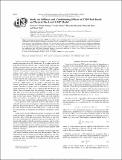Study on Stiffness and Conditioning Effects of CMP Pad Based on Physical Die-Level CMP Model
Author(s)
Boning, Duane S.; Fan, Wei; Charns, Leslie; Miyauchi, Hiroyuki; Tano, Hiroyuki; Tsuji, Shoei; ... Show more Show less
DownloadBoning-Study on stiffness.pdf (1.084Mb)
PUBLISHER_POLICY
Publisher Policy
Article is made available in accordance with the publisher's policy and may be subject to US copyright law. Please refer to the publisher's site for terms of use.
Terms of use
Metadata
Show full item recordAbstract
Chemical mechanical planarization (CMP) pad stiffness and conditioning effects were evaluated based on a physical die-level CMP model, with pad effective modulus and asperity height as parameters. In one study, patterned dielectric wafers were polished using polymeric pads of different stiffnesses. In a second study, wafers were polished by standard pads using different conditioning disks. Polishing experimental data (dielectric thickness and step height) were fitted by the physical model, enabling the extraction of the pad effective modulus and asperity height model parameters. A higher pad stiffness gives better within-die uniformity, and the conditioning disk with blocky diamonds achieves up-area only polishing for longer times. Polishing simulations using the physical model reflect a clear pattern density dependence.
Date issued
2010-04Department
Massachusetts Institute of Technology. Department of Electrical Engineering and Computer ScienceJournal
Journal of the Electrochemical Society
Publisher
Electrochemical Society
Citation
Fan, Wei et al. “Study on Stiffness and Conditioning Effects of CMP Pad Based on Physical Die-Level CMP Model.” Journal of The Electrochemical Society 157.5 (2010): H526. ©2010 The Electrochemical Society
Version: Final published version
ISSN
0013-4651